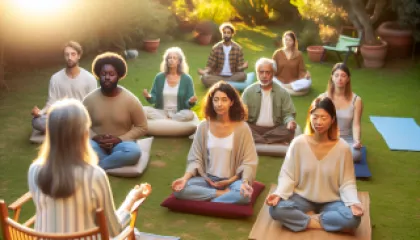How Do Colors in Interiors Affect Mental Health?
How Do Colors in Interiors Affect Mental Health?
Imagine stepping into a room that feels instantly calming and serene, the walls adorned with soothing hues that immediately put your mind at ease. Or picture a vibrant, energetic space that invigorates your senses and lifts your mood. The colors we surround ourselves with in our interiors have a profound impact on our mental health and overall well-being.
In this comprehensive guide, we'll explore the fascinating intersection of psychology, color theory, and interior design. We'll delve into the scientific research behind the emotional and cognitive effects of different colors, offering practical insights that can help you create harmonious, mentally nourishing spaces in your own home or workplace.
The Psychology of Color: Understanding the Emotional Impact
Colors are more than just aesthetic choices; they evoke deep-rooted psychological and physiological responses within us. Each hue on the color spectrum has the power to influence our mood, cognition, and even our physical well-being. By understanding the inherent qualities and associations of different colors, we can harness their potential to enhance our mental health and overall quality of life.
Warm Colors: Energizing and Stimulating
Warm colors, such as red, orange, and yellow, are often associated with feelings of energy, excitement, and passion. These vibrant hues can stimulate the senses and evoke a sense of warmth and comfort. However, when used excessively or in the wrong context, warm colors can also induce feelings of anxiety, aggression, or even physical arousal.
Red, for instance, is a powerful color that can raise blood pressure, increase respiration, and even trigger the release of adrenaline. While it can be used effectively in small doses to create a sense of excitement or drama, an overabundance of red in a space can be overwhelming and lead to feelings of agitation or restlessness.
Orange, on the other hand, is a more balanced warm color that combines the energy of red with the cheerfulness of yellow. It is often associated with creativity, sociability, and a sense of optimism. However, like red, too much orange can become visually fatiguing and disrupt the calm atmosphere of a room.
Yellow, the brightest of the warm colors, is known for its uplifting and cheerful qualities. It can stimulate the mind, enhance concentration, and even boost feelings of happiness. However, it's important to use yellow judiciously, as an excess of this vibrant hue can become overwhelming and cause eye strain or headaches.
Cool Colors: Calming and Soothing
In contrast to warm colors, cool hues such as blue, green, and purple are often associated with feelings of calmness, serenity, and relaxation. These colors can have a soothing effect on the mind and body, helping to reduce stress, lower blood pressure, and promote a sense of mental clarity.
Blue, the most commonly cited "favorite color," is known for its calming and introspective qualities. It can have a tranquil, almost meditative effect, slowing the heart rate and inducing a sense of peace. However, certain shades of blue, such as those with a strong green undertone, can also evoke feelings of sadness or depression if used excessively.
Green, the color of nature, is often associated with growth, harmony, and balance. It has a restorative effect, helping to reduce feelings of anxiety and promote a sense of well-being. The earthy tones of green can also foster a connection to the natural world, which has its own mental health benefits.
Purple, a blend of the cool, calming blue and the warm, stimulating red, is a color that can evoke a range of emotional responses. Lighter, more muted shades of purple can have a soothing, introspective effect, while deeper, richer hues can feel more luxurious and indulgent. The psychological impact of purple can also vary based on personal associations and cultural contexts.
The Influence of Color on Cognitive Function and Behavior
The psychological impact of color extends beyond just our emotions; it can also influence our cognitive functions, perception, and behavior. Understanding these complex relationships can help us make more informed decisions about the colors we choose for our living and working spaces.
Color and Attention
Certain colors have the ability to capture our attention and focus more effectively than others. Warm, high-contrast colors like red and yellow are often used in signage and branding to draw the eye and convey a sense of urgency or importance. In an interior design context, these attention-grabbing hues can be strategically placed to highlight key architectural features or draw the viewer's gaze to specific areas of a room.
On the other hand, cool, low-contrast colors like blue and green tend to have a more calming, receding effect, allowing the mind to relax and reducing visual fatigue. These soothing hues can be particularly beneficial in spaces where concentration and focus are crucial, such as home offices, study areas, or meditation rooms.
Color and Productivity
The colors we surround ourselves with can also have a direct impact on our productivity and cognitive performance. Warm, stimulating colors like red and orange have been shown to enhance mental alertness and physical energy, making them well-suited for areas where creativity, problem-solving, or physical activity are the primary focus.
Conversely, cool, calming colors like blue and green can promote a sense of tranquility and focus, which can be particularly beneficial in work environments that require sustained attention, analytical thinking, or meticulous attention to detail. By strategically incorporating these hues, we can create interior spaces that support our cognitive needs and optimize our productivity.
Color and Mood
The emotional impact of color is perhaps the most widely recognized aspect of its psychological influence. As we've explored, warm colors tend to evoke feelings of energy and excitement, while cool colors are often associated with calmness and relaxation.
However, the specific mood-enhancing or mood-regulating effects of color can also vary based on personal preferences, cultural associations, and individual experiences. For example, some individuals may find that the vibrancy of red or orange lifts their spirits and boosts their mood, while others may find these colors overstimulating or even anxiety-inducing.
Understanding these individual differences in color perception and associations can help us create interior spaces that cater to the unique emotional needs and preferences of the people who occupy them. By carefully curating the color palette in our homes and workplaces, we can cultivate environments that support our mental well-being and foster a sense of calm, contentment, and overall emotional balance.
Applying Color Psychology to Interior Design
Now that we've explored the fascinating world of color psychology, let's delve into how we can apply these principles to create mentally nourishing interior spaces. By strategically incorporating color into our homes and workplaces, we can harness the power of these hues to support our mental health and overall well-being.
Color Combinations and Harmonious Palettes
When it comes to interior design, the strategic use of color combinations can have a significant impact on the overall atmosphere and emotional resonance of a space. Harmonious color schemes, which are characterized by hues that complement each other on the color wheel, can create a sense of balance, cohesion, and visual comfort.
For example, a palette that pairs cool blues and greens can evoke a calming, serene ambiance, while a combination of warm reds, oranges, and yellows can inject a vibrant, energizing feel. By carefully selecting and arranging these color harmonies, we can craft interior environments that cater to our specific emotional and cognitive needs.
Accent Colors and Focal Points
In addition to creating harmonious color schemes, the strategic use of accent colors and focal points can also play a crucial role in shaping the psychological impact of an interior space. Accent colors, which are used sparingly to highlight specific elements or draw the eye to particular areas, can be leveraged to create visual interest, direct attention, and even evoke specific emotional responses.
For instance, a muted, neutral-toned room can be enlivened by the strategic placement of a vibrant, attention-grabbing accent wall or a bold, colorful piece of artwork. These focal points can serve to energize the space, stimulate the senses, and even inspire creativity or contemplation, depending on the specific color choices and their psychological associations.
Color and Lighting
The interplay between color and lighting is another crucial consideration in interior design, as it can significantly impact the perceived atmosphere and emotional resonance of a space. Different lighting conditions can dramatically alter the way colors are perceived, influencing their emotional and cognitive effects.
Warm, incandescent lighting, for example, can enhance the cozy, inviting qualities of earth-toned colors, while cool, blue-tinted LED lighting can amplify the calming, serene nature of blues and greens. By thoughtfully integrating lighting solutions that complement the chosen color palette, designers can create interior spaces that are not only visually harmonious but also emotionally and psychologically supportive.
Designing for Mental Health: Practical Tips and Considerations
With a deeper understanding of the psychological impact of color, let's explore some practical tips and considerations for designing interior spaces that actively support mental health and well-being.
Mindful Color Selection
When selecting colors for your interior spaces, it's essential to consider the specific emotional and cognitive needs of the individuals who will be occupying those spaces. This may involve taking into account factors such as age, gender, cultural background, and personal preferences, as well as the primary activities and functions of the room.
For example, a home office or study area may benefit from a more subdued, cool-toned color scheme to promote focus and concentration, while a living room or gathering space could incorporate warmer, more energizing hues to foster a sense of sociability and relaxation.
Balancing Color Palettes
While it's important to select colors that align with the desired emotional and cognitive effects, it's also crucial to maintain a balanced and harmonious color palette. Overuse of any single color, regardless of its psychological properties, can lead to visual fatigue, discomfort, and even negative emotional responses.
To create a well-balanced interior, consider incorporating a mix of warm and cool tones, as well as varying levels of intensity and saturation. This allows for a more dynamic and visually interesting space that can cater to a range of emotional needs and preferences.
Incorporating Natural Elements
Biophilic design, the concept of incorporating natural elements and materials into interior spaces, can be a powerful tool for supporting mental health and well-being. Studies have shown that exposure to nature, whether through direct interaction or the integration of natural motifs and textures, can have a profoundly calming and restorative effect on the mind and body.
By strategically incorporating natural colors, textures, and materials into your interior design, you can create a sense of connection to the natural world, which can in turn promote feelings of tranquility, reduced stress, and increased focus and productivity.
Adaptability and Personalization
Finally, it's important to recognize that the psychological impact of color is highly individual and context-dependent. What may be calming and restorative for one person may be overstimulating or even anxiety-inducing for another. To truly support the mental health of the inhabitants, interior spaces should be designed with adaptability and personalization in mind.
This may involve incorporating flexible, modular design elements that allow for easy color and layout changes, or creating spaces that can be customized to suit the unique preferences and needs of the occupants. By empowering individuals to shape their surrounding environment, we can foster a greater sense of ownership, control, and overall well-being.
Conclusion: Cultivating Mentally Nourishing Spaces
The colors we surround ourselves with in our interior spaces have a profound impact on our mental health and overall well-being. By understanding the psychological and emotional effects of different hues, we can strategically incorporate color into our homes and workplaces to create environments that support our cognitive functions, regulate our moods, and promote a sense of calm, balance, and mental clarity.
Whether you're designing a new space or refreshing an existing one, consider the principles of color psychology and apply them with intention and thoughtfulness. By creating harmonious, visually stimulating, and mentally nourishing interiors, you can unlock the transformative power of color and cultivate spaces that truly empower and enrich the lives of those who inhabit them.
Remember, the journey of harmonizing color and mental health is an ongoing exploration, as unique as the individuals and spaces it aims to serve. Embrace the opportunity to experiment, observe, and continuously refine your approach, always keeping the well-being of the occupants at the forefront of your design decisions.
By doing so, you'll not only create visually stunning interiors but also foster environments that nourish the mind, body, and spirit - spaces that inspire, empower, and ultimately, enhance the quality of life for all who step within.






